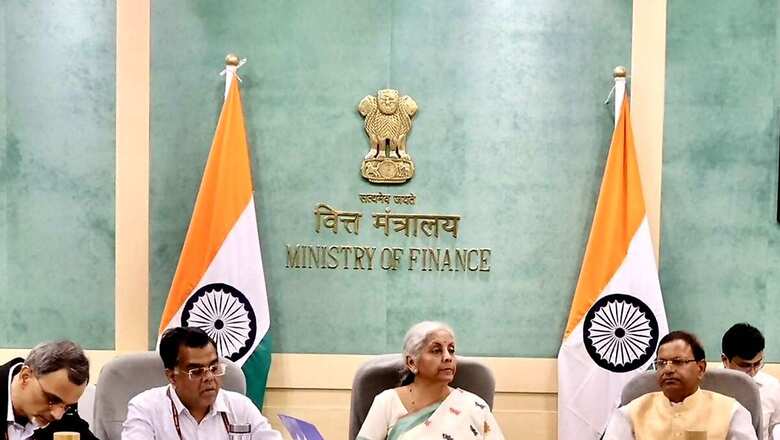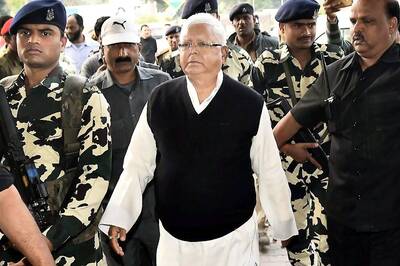
views
The first budget to be presented by the BJP-led coalition on July 23, 2024, is anticipated to be bold and inclusive, yet business-friendly, with several big-ticket initiatives. Contrary to popular perception that a coalition government at the Centre would slow down the pace of reform and implementation, coalitions in the past have delivered pathbreaking economic reforms, as India did in 1991.
It is expected that the present dispensation at the Centre would want to fast-track economic reforms. Synergies are at play, as Modi is a doer, backed by a progressive ally in Chandrababu Naidu. Both leaders would be astute in addressing concerns raised by the CSDS post-poll survey that highlighted unemployment and price rise as dominant factors that shaped voter choices in the 2024 general elections.
Consequently, the BJP-led NDA is expected to prove its unanimity in accelerating the pace of economic growth with an even greater sense of urgency, by laying the roadmap for 2024-25.
Creation of higher paying jobs and raising per capita income would be the ultimate end-goal
Leapfrogging from being a ‘low-income economy’ to a ‘middle-income economy’ within the next 25 years requires raising per capita income from the present $2600 to $10,205. For inclusive growth, the Indian government’s immediate concern would be towards creating better-paying jobs capable of employing the four million people entering the workforce annually. The ultimate goal is to transition 44 per cent of those currently in agriculture and 42 per cent in the informal sector into higher-paying jobs.
India’s robust growth remains on the ascendant
India continues to remain in a sweet macroeconomic spot, even in the third consecutive term of the NDA. Upward revisions for the 2025 growth forecasts projected by multilateral institutions like the ADB, IMF, and UNCTAD at 7 per cent bode well for the continuity of India’s growth momentum, especially compared to China’s slowing growth and the tepid global growth forecast anticipated at 3.1 per cent.
However, it is time high the GDP translates to job creation.
Infrastructure-led growth expected to continue
Regarding India-centric financials, the finance minister is well-armed to continue with the path of infrastructure-led growth which the government has pursued so far. This approach will ultimately help attract private investment and increase economic intensity, as it has a multiplier effect due to the 200 ancillary industries that feed off building and construction projects. The outlay of Rs 11.11 lakh crore towards capital expenditure announced in the interim budget is likely to be maintained and could, in fact, be further increased.
This is due to the RBI’s massive dividend of Rs 2.21 lakh crore and increased tax compliance and buoyancy, which reduce the finance minister’s compulsion towards strict fiscal prudence, allowing her space to flex the fiscal deficit, which would be around 5.6 per cent of GDP.
Let’s bear in mind that during the growth trajectory of developing nations, fiscal consolidation should remain flexible if it conforms to reasonable band limits. This is because cheaper and long-term finance is most needed for funding industry, job creation, and greening of the economy. Incurring a higher fiscal deficit, when used for asset creation, is deemed as ‘good debt.’ This includes higher spending on roads, rail, airports, and highways, which are also employment-intensive.
Briefly, and broadly, a few of the budget expectations which have the potential to increase employment are as follows-
- Priority is expected to be accorded to addressing key issues thrown up by the recent electoral outcomes which pertained to: under-employment, low rural consumption due to rural distress, reviving the CapEx cycle for private investment, and raising long-term capital that is much needed for greening the economy.
- Aspiring to become the third-largest global economy must necessarily envision policies conducive to raising growth rates beyond 8 per cent year-on-year, and ensure that such growth is equitable and has a trickle-down effect to the bottom of the economic pyramid.
- Freebies and ongoing schemes like MGNREGA and PM Kisan Yojana are only interim and stop-gap welfarist measures. However, these two schemes also need to be inflation-adjusted. The PM Kisan Yojana needs to be raised to at least 8,000 rupees, while both wages and employment duration for MGNREGA need to be increased.
- Even if larger expenditure outlays are allocated towards welfare spending, it is unlikely to affect any reduction in the quality of public capital expenditure, given the higher-than-expected dividend transfer from the RBI.
- Higher allocations towards Human Development Indices like health care, education and skilling in proportion to GDP need a drastic increase. Healthcare spending needs to be increased to at least 4 per cent of GDP, while education needs to be 6 per cent of GDP.
- Achieving a desired GDP growth rate of over 8 per cent largely depends on improving our manufacturing and export performance. This can be achieved by moving towards a lower import tariff regime to improve export competitiveness, as we need to integrate with global value chains.
- The statistics that need a relook are – We still have 45 per cent of our workforce stuck in agriculture; manufacturing accounts for only 15 per cent of GDP, while India’s share of global exports languishes at 2 per cent. In order to expedite the transition of the agricultural population to manufacturing, services, and exports, there is a need to incentivise labour-intensive manufacturing to absorb the semi-skilled workforce.
- The PLI scheme could be extended beyond the current 14 sectors to include traditional labour-intensive sectors such as textiles, toys, gems and jewellery, furniture, leather, apparel, retail, and tourism. This expansion aims to bolster India’s appeal as an investment destination and build a robust supply chain ecosystem.
- Another big potential for labour-intensive employment generation lies in urbanisation, as 60 per cent of India is yet to be urbanised, and urgent upgrades are needed to revamp India’s existing archaic urban infrastructure.
- While an increase in FDI is good news for the economy, technological advancements in manufacturing, being capital-intensive, exclude large sections of the unskilled and under-literate labour force. Since labour-substituting technologies do not facilitate large-scale employment absorption, this underscores the need for various avenues to be explored for labour-intensive job creation.
- The GoI is expected to expedite long-pending Factor Market Reforms which pertain to ease of land acquisition, enforcing new labour codes, lowering the cost of capital and power to competitive rates, fast-tracking dispute resolution to ensure enforcement of contracts, decriminalisation of certain corporate and tax laws, and further reducing compliances.
- Ease of doing business remains a hurdle also due to a lack of consensus between the state and the Centre, as land, labour, power, and agriculture come under the Concurrent List, necessitating greater federal cooperation. Budget 2024, and thereafter, hopefully, would pave the path towards finding solutions to resolve this impasse.
- It is a proven fact that women’s participation in the workforce can boost global GDP by $28 trillion. India lags behind in this sphere, so it is imperative we close the gender gap in India’s labour force, which could potentially elevate the country’s GDP by 27 per cent.
- Regarding the global debate on wealth redistribution and inequality in income and opportunities, a more crucial objective is to uplift people from multidimensional poverty through fostering ‘good capitalism’ that triggers job creation. Therefore, corporate taxation should remain globally competitive, and the sunset clause allowing new industries to benefit from a 15 per cent tax rate should be extended.
- India has yet to optimally reap the benefits of the ‘China +1’ policy, where multinational corporations are looking to relocate to other Asian regions. Economies with strong fundamentals and policy stability are poised to attract an increasing share of essential global capital. The budget must foster an ecosystem conducive to maximising the potential of ‘C+1’, a critical opportunity that cannot be overlooked this time.
In hindsight, it is to the credit of the Modi-led NDA government that between 2014 and 2024, a total of 51.4 million jobs were generated. Of these, 19.79 million were created through government initiatives, while the remaining 31.61 million resulted from credit-based interventions. The SKOCH Group, which has advocated for formal access to credit as a means of generating self-employment, provided this data. However, much more needs to be done in this budget to increase per capita income through better-paying jobs.
In conclusion, Budget 2024 would be a missed opportunity if it fails to course-correct historic failures, as every section of society is looking for relief and concessions.
Bindu Dalmia is ex-Chairperson for the Committee for Financial Inclusion, NITI Aayog. Views expressed in the above piece are personal and solely those of the author. They do not necessarily reflect News18’s views.

















Comments
0 comment